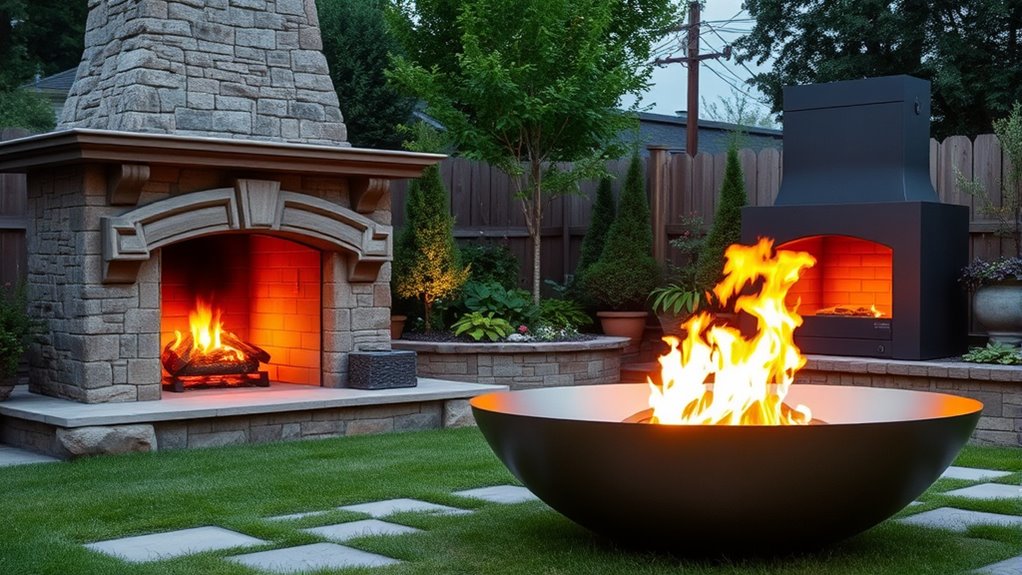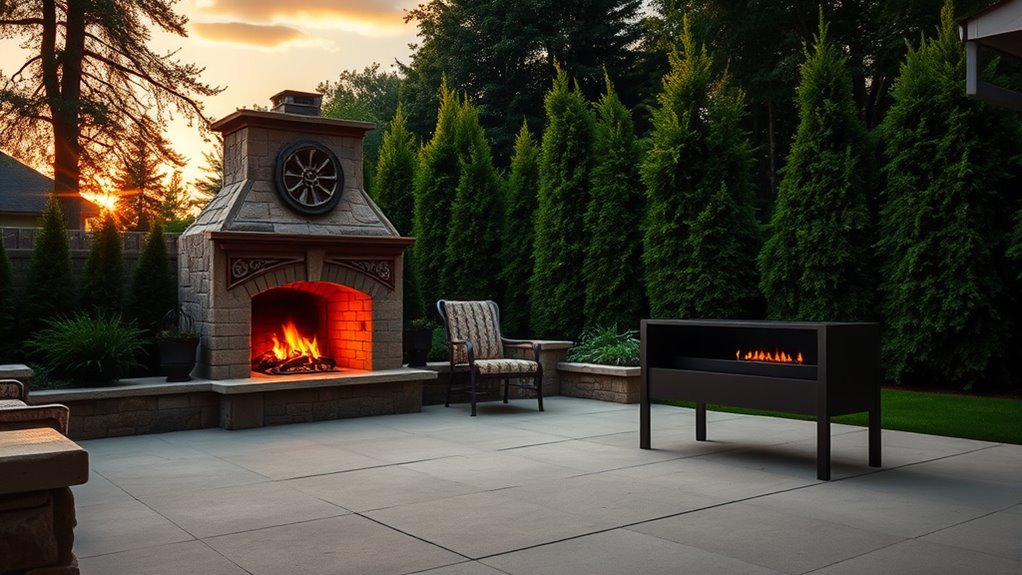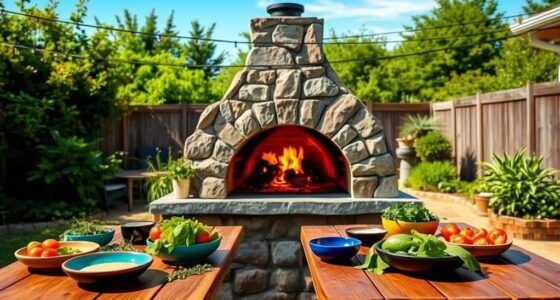When choosing a backyard fireplace, consider whether you want it to be a stunning focal point or primarily functional. Traditional wood-burning models offer rustic charm and ambiance but need more maintenance, while gas fireplaces provide clean, easy operation with versatile installation options. Electric units maximize convenience and safety but might lack the heat of their counterparts. Balancing style and function depends on your space, lifestyle, and priorities—explore more to find the perfect fit for your outdoor oasis.
Key Takeaways
- Choose wood-burning fireplaces for authentic ambiance but consider maintenance and safety needs.
- Gas fireplaces offer low-maintenance, clean-burning options with adjustable flames for convenience.
- Electric fireplaces prioritize ambiance with minimal setup, suitable for small or temporary outdoor spaces.
- Material and size impact both aesthetic appeal and durability, influencing the fireplace’s style and functionality.
- Balance design and practicality by selecting a fireplace that complements your outdoor space while meeting safety and usage needs.

A backyard fireplace instantly transforms your outdoor space into a cozy gathering spot. It sets the tone for relaxing evenings, lively get-togethers, or peaceful moments alone. But choosing the right fireplace isn’t just about aesthetics—it’s about balancing style and functionality to suit your needs. The options are diverse, from traditional wood-burning models to sleek electric units, each offering different benefits and challenges.
A backyard fireplace creates a warm, inviting outdoor space perfect for relaxing or entertaining.
If you love the authentic experience of crackling wood and visible flames, a wood-burning fireplace like Castlewood or Villawood is perfect. These models emphasize tradition, creating a rustic charm that enhances outdoor spaces with a warm, natural ambiance. Keep in mind, though, that they demand regular maintenance—cleaning out ash, managing smoke, and ensuring proper ventilation. They also require more space and planning for safe operation, especially if you have nearby structures or plantings. Still, the sight and sound of a real fire make it worth the effort if authenticity matters most to you.
Gas fireplaces, such as Vesper, strike a different balance. They often feature stainless steel construction and ventless designs, making installation simpler and more flexible. You won’t need a chimney or extensive venting, which means you can install them in more locations, even on decks or small patios. Gas models provide cleaner operation, with easy control over flame size and heat output, and they tend to be more consistent and low-maintenance. If convenience and efficiency top your list, a gas fireplace might be your best choice—offering a warm glow with less fuss. Additionally, gas fireplaces are available in various sizes and styles to complement your outdoor decor. To maximize safety and longevity, selecting high-quality materials is essential, especially when exposed to outdoor elements.
Electric fireplaces, like the Forum model, are even more low-key. They produce flames through visual effects, requiring no fuel, venting, or cleanup. This makes them an excellent option for smaller or less permanent setups, such as rental decks or balconies. They don’t generate heat unless you choose a model with heating capabilities, but their primary appeal is ambiance and ease of use. You get the cozy look of a fire without any of the mess or safety concerns associated with real flames.
Material choices also influence style and maintenance. Brick offers durability and a traditional aesthetic, perfect for colonial or farmhouse looks. Natural stone, like Pennsylvania fieldstone or limestone, lends a rustic or modern vibe, blending seamlessly with landscape features. Stucco and concrete provide sleek, contemporary styles but may discolor over time and require more upkeep. Your choice impacts not just looks but how well the fireplace withstands weather and how easy it is to clean.
Size and placement matter too. Larger fireboxes create a dramatic focal point and support group gatherings, while smaller units fit tighter spaces. Positioning your fireplace thoughtfully—away from combustible materials and considering sun exposure or wind—ensures safety and comfort. Whether built into an outdoor kitchen or standing alone on the patio, your fireplace should complement your outdoor design and meet your functional needs, creating a warm, inviting outdoor room that balances style with practical use.
Frequently Asked Questions
What Are the Best Materials for Durable Backyard Fireplaces?
When choosing materials for a durable backyard fireplace, you’ll want options that withstand weather and high heat. Brick and natural stone are excellent because they resist cracking and aging well. Refractory concrete linings inside the firebox boost heat resistance, while stainless steel or cast iron components handle the outdoor elements. Combining these materials guarantees your fireplace remains functional and looks great over time, even in challenging weather conditions.
How Do I Ensure Proper Safety Measures When Using a Backyard Fireplace?
When using your backyard fireplace, you should follow essential safety measures. Place it on a stable, non-flammable surface and keep it at least 10 feet from structures and overhanging objects. Use dry, seasoned wood and avoid accelerants. Maintain a safe perimeter, keep children and pets away, and always supervise the fire. Regularly clean and inspect your fireplace, and have fire extinguishing tools nearby to prevent accidents.
Can Backyard Fireplaces Be Integrated Into Existing Outdoor Kitchen Setups?
You might think integrating a backyard fireplace into your outdoor kitchen is complicated, but it’s entirely feasible with proper planning. First, guarantee there’s enough space and that materials match your existing setup. You’ll need to reroute utilities like gas or electric lines and consider safety clearances. Proper placement near seating and cooking areas enhances socializing, while weather-resistant materials and good ventilation keep the space functional and safe year-round.
What Are the Legal Regulations or Permits Needed for Installing a Backyard Fireplace?
You need to check local building codes before installing a backyard fireplace. Usually, you’ll require permits if your fireplace involves structural changes like chimneys or venting. You might also need fire authority approval, especially for larger or taller fireplaces, and inspections after installation. Make certain your setup follows setback distances and clearance rules to avoid fines or removal. Hiring professionals familiar with local regulations can help streamline the permit process and ensure compliance.
How Do Climate Differences Affect the Choice of Fireplace Style and Functionality?
Did you know that 60% of homeowners in colder regions choose fireplaces with high thermal mass? Climate greatly influences your fireplace’s style and function. In cold areas, you’ll want durable materials like stone for heat retention, while milder climates suit lightweight metals for quick cooling. Coastal or humid regions require rust-resistant options. Your choice should match seasonal needs, safety codes, and local weather patterns to guarantee comfort and longevity.
Conclusion
Ultimately, your backyard fireplace is the heart of your outdoor space, blending style with function like a well-choreographed dance. Whether you choose a sleek modern design or a cozy rustic charm, remember that it’s your personal oasis. Prioritize what matters most—whether warmth, ambiance, or visual appeal—and let your fireplace be the centerpiece that brings everything together. With the right balance, your backyard will become a warm embrace that invites memories to unfold.








